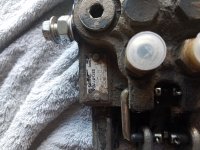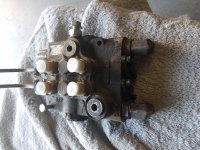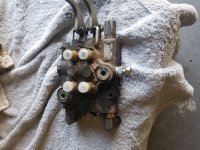Can anyone tell me what front loader this is?
Thanks for your time and help!!
I don't know the make, but it definitely isn't a factory loader. It might just be the photos, but I cannot see how it is mounted to the tractort so I can't even be sure if what I'm about to write applies....
The problem with some after-market loaders wasn't that the loaders were bad - they are pretty basic and OK. The problem was that instead of being attached to a loader subframe to protect the tractor, often one size of loader was fitted to a variety of tractors by simply bolting it onto some convenient point like the bellhousing in the middle of the tractor. Bellhousings aren't built for that, and problems happen.
Here is how loaders ought to be attached. All the OEM ones use some variation of a subframe to spread out the stresses.
Normally loaders will have a subframe composed of two fairly heavy metal sections - one on on each side - and that reach from where they are bolted to the forward part of the engine mounting all the way back to where they are bolted to the rear axle housing. That provides the support necessary for pushing and pulling with the loader bucket.
Each loader upright is also attached to this subframe on each side. That's the connection that is just forward of your feet when you are sitting on the tractor. The uprights connect to the subframe rather than the tractor. That is so that all the lifting forces on the bucket are carried by the loader subframe.
Finally, the subframe on each side is then connected to the other subframe - usually this is done with an even heavier steel member than goes under the tractor without touching anything and connects to the subframe on the other side. A handy place for this is to put it under the tractor so that it connects one loader upright to the other loader upright. Normally this underneath piece will not make any structural connection to the tractor or bellhousing at all. It connects the uprights to take care of any twisting forces on the loader when it is pushing and especially when it is lifting an off-center load.
Some heavy duty loaders also connect the top of the uprights together with a bar just forward of the steering wheel. That's even nicer.
As you can imagine, making a loader is pretty simple for a small manufacturer to do compared with the hassle of making a whole line of accurate subframes so that his loader will properly fit a variety of similar sized - but slightly different - tractors. So some of the cheaper loaders didn't use a subframe at all...they just came with some brackets to connect to the tractor in the hopes that the tractor could handle it and the owner accepted the responsibility.
The good news is that if you have such a loader already mounted, then it's simple basic metal work to work up a subframe to help it out.
Any welding shop could do it in a day. Until then, just take it easy and don't strain that universal loader. It is OK for light tasks.
luck,
rScotty



